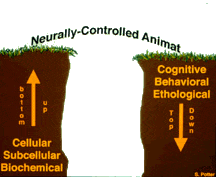An animat is a computer simulated or robotic animal behaving in an environment. Our interfacing of cultures to a simulated environment was the first Neurally-Controlled Animat. We are creating a method to study how information is processed and encoded in living cultured neuronal networks by interfacing them to the Animat, within a virtual world.
Setup
Cortical neurons from rats are dissociated and cultured on a surface containing a grid of electrodes (multi-electrode arrays, or MEAs) capable of both recording and stimulating neural activity. Distributed patterns of neural activity are used to control the behavior of the Animat in a simulated environment. The computer acts as its sensory system providing electrical feedback to the network about the Animat’s movement within its environment.

Changes in the Animat’s behavior due to interaction with its surroundings are studied in concert with the biological processes (e.g., neural plasticity) that produced those changes, to understand how information is processed and encoded within a living neural network. Thus, we have created a hybrid real-time processing engine and control system that consists of living, electronic, and simulated components. This approach may be applied to controlling robotic devices, or lead to better real-time silicon-based information processing and control algorithms that are fault tolerant and can repair themselves.
Experiments
Hybrot
The goal of the hybrot experiment was to create a neural interface between neuron and robot that would exhibit a behaviour of approach and avoidance. That is approach a target object but not collide with it, maintaining a desired distance from the target. If a given neural reaction is repeatable with low variance, then the response may be used to control a robot to handle a specific task.

We used the Koala and Khepera robots (manufactured by K-Team) to embody the cul-tured network, and to provide an environment with a moving object. The Koala robot was used as the neurally controlled robot (also called hybrid living robot or hybrot), while the Khepera served as the reference object, moving at random under computer control. Under neural control, the Koala successfully approached the Khepera and maintained a distance from it, moving forward if the Khepera moved away, or backing up if the Khepera approached.
In addition to demonstrating the computational capacity inherent in cultured neurons, this hybrot can be used to study learning in cultured neural networks.
MEART (MultiElectrode Array Art)
Meart (Multi-Electrode Array art) is a hybrot built in collaboration with the SymbioticA Research Group . The project explores epistemological, ethical and aesthetical issues concerning the use of living neurons for ethno-centric end.
Further reading
- Thomas B. DeMarse, Daniel A. Wagenaar, Axel W. Blau & Steve M. Potter;
The Neurally Controlled Animat: Biological Brains Acting with Simulated Bodies. - Shkolnik, A. C. Neurally Controlled Simulated Robot: Applying Cultured Neurons to Handle and Approach/Avoidance Task in Real Time, and a Framework for Studying Learning In Vitro. In: Potter,
S. M. & Lu, J.: Dept. of Mathematics and Computer Science. Emory University, Atlanta (2003).


